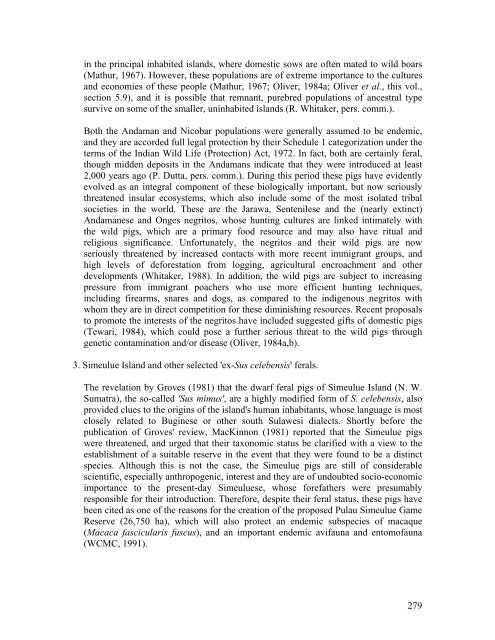The Afrotropical Suids - IUCN
The Afrotropical Suids - IUCN
The Afrotropical Suids - IUCN
Create successful ePaper yourself
Turn your PDF publications into a flip-book with our unique Google optimized e-Paper software.
in the principal inhabited islands, where domestic sows are often mated to wild boars<br />
(Mathur, 1967). However, these populations are of extreme importance to the cultures<br />
and economies of these people (Mathur, 1967; Oliver, 1984a; Oliver et al., this vol.,<br />
section 5.9), and it is possible that remnant, purebred populations of ancestral type<br />
survive on some of the smaller, uninhabited islands (R. Whitaker, pers. comm.).<br />
Both the Andaman and Nicobar populations were generally assumed to be endemic,<br />
and they are accorded full legal protection by their Schedule 1 categorization under the<br />
terms of the Indian Wild Life (Protection) Act, 1972. In fact, both are certainly feral,<br />
though midden deposits in the Andamans indicate that they were introduced at least<br />
2,000 years ago (P. Dutta, pers. comm.). During this period these pigs have evidently<br />
evolved as an integral component of these biologically important, but now seriously<br />
threatened insular ecosystems, which also include some of the most isolated tribal<br />
societies in the world. <strong>The</strong>se are the Jarawa, Sentenilese and the (nearly extinct)<br />
Andamanese and Onges negritos, whose hunting cultures are linked intimately with<br />
the wild pigs, which are a primary food resource and may also have ritual and<br />
religious significance. Unfortunately, the negritos and their wild pigs are now<br />
seriously threatened by increased contacts with more recent immigrant groups, and<br />
high levels of deforestation from logging, agricultural encroachment and other<br />
developments (Whitaker, 1988). In addition, the wild pigs are subject to increasing<br />
pressure from immigrant poachers who use more efficient hunting techniques,<br />
including firearms, snares and dogs, as compared to the indigenous negritos with<br />
whom they are in direct competition for these diminishing resources. Recent proposals<br />
to promote the interests of the negritos have included suggested gifts of domestic pigs<br />
(Tewari, 1984), which could pose a further serious threat to the wild pigs through<br />
genetic contamination and/or disease (Oliver, 1984a,b).<br />
3. Simeulue Island and other selected 'ex-Sus celebensis' ferals.<br />
<strong>The</strong> revelation by Groves (1981) that the dwarf feral pigs of Simeulue Island (N. W.<br />
Sumatra), the so-called 'Sus mimus', are a highly modified form of S. celebensis, also<br />
provided clues to the origins of the island's human inhabitants, whose language is most<br />
closely related to Buginese or other south Sulawesi dialects. Shortly before the<br />
publication of Groves' review, MacKinnon (1981) reported that the Simeulue pigs<br />
were threatened, and urged that their taxonomic status be clarified with a view to the<br />
establishment of a suitable reserve in the event that they were found to be a distinct<br />
species. Although this is not the case, the Simeulue pigs are still of considerable<br />
scientific, especially anthropogenic, interest and they are of undoubted socio-economic<br />
importance to the present-day Simeuluese, whose forefathers were presumably<br />
responsible for their introduction. <strong>The</strong>refore, despite their feral status, these pigs have<br />
been cited as one of the reasons for the creation of the proposed Pulau Simeulue Game<br />
Reserve (26,750 ha), which will also protect an endemic subspecies of macaque<br />
(Macaca fascicularis fuscus), and an important endemic avifauna and entomofauna<br />
(WCMC, 1991).<br />
279












